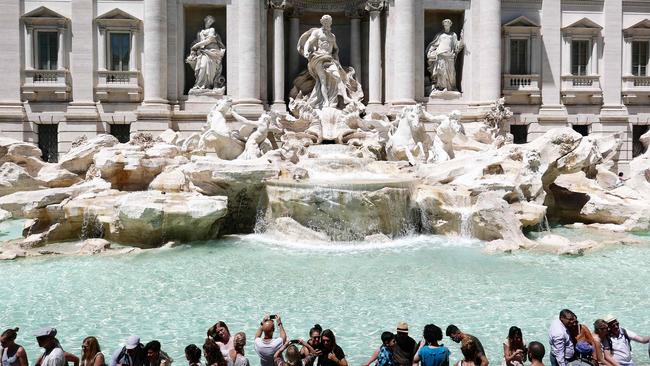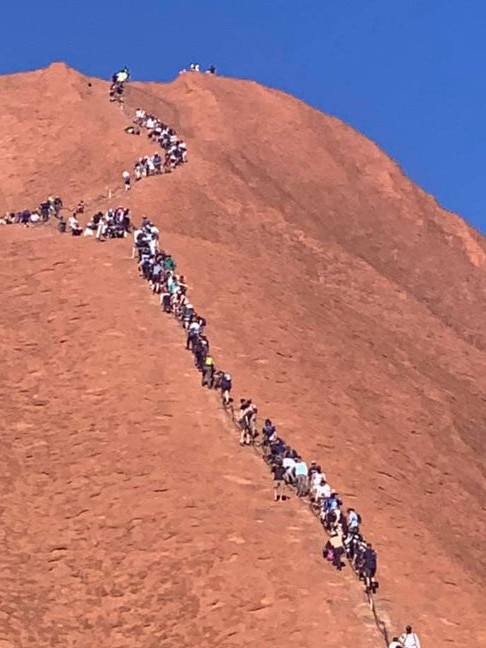Just because you still can climb Uluru doesn’t mean you should
As the ban on climbing Uluru approaches, tourists are flocking to the Northern Territory to snap the ultimate Instagram brag photo before it’s too late. But they’re forgetting one crucial thing, writes Lauren Roberts.

Rendezview
Don't miss out on the headlines from Rendezview. Followed categories will be added to My News.
Climbing Uluru is not a bucket list item. It’s not something you ‘need’ to do before the climb is closed for good on October 26.
It’s not a right, not an entitlement of being a ‘true blue Aussie’.
It’s disrespectful.
RELATED: Huge lines of tourists climbing ‘dangerously close’ at Uluru
Anyone who thinks they need to climb Uluru before the closure — well, simply put, they need to check their entitlement.
Why do people think their desire to traipse all over a sacred site is more important than the wishes of the people connected to the lands?
Year after year, the Anangu traditional owners have asked travellers to respect the rock’s cultural value by not climbing it.

And year after year, people ignore that request and climb it anyway.
“Please do not climb. This is our home.”
These are the words at the base of Uluru. It’s impossible to miss them.
But, as this week has shown, it’s very possible to just ignore them.
In 2017, about 140 people were ascending the rock each day, but that figure has skyrocketed to about 400 people a day as the climb ban approaches.
Along the way, they litter. Human waste and rubbish has been strewn across the rock and around the sacred lands as entitled tourists disregard the wishes of traditional owners and scale Uluru.
MORE FROM LAUREN ROBERTS: Abortion should not be a dirty word
The climb has also damaged the rock itself, with a huge white scar from tourists walking the same path being visible from a distance.
This week, shocking images of people climbing Uluru have emerged online.
Hundreds of people, linked together in a tight line, snaking up the massive sandstone rock.
And where tourists will go, rubbish follows.

At the moment, rangers cannot clean all the filth tourists are leaving behind.
Imagine someone throwing rubbish into the Trevi Fountain or urinating on the Eiffel Tower.
To the Anangu traditional owners, climbing Uluru and trashing the sacred land around it is as bad as it gets.
Obvious disrespect aside, however, an influx of tourists is great news for Central Australia’s tourism industry.
RELATED: Uluru closes to tourists for good in October
All up, 400,000 people visited the park in the last financial year. That’s 400,000 spending money in Central Australia — buying tours, meals, accommodation.
And while hundreds have chosen to climb the rock, many more have been happy to wander the 10km around its base.
They’ve listened to the land’s traditional owners and made an informed decision to admire the natural wonder respectfully.
I’ve been to Uluru and it’s a breathtaking sight.

You do not need to climb the rock to be in awe of the natural wonder. Uluru stands 348m tall, and is roughly half a billion years old.
The sandstone illuminates at sunrise and sunset, with the warm colours of the sun bouncing off the ochre rock.
In parts, Uluru is lush and green; sometimes with free-flowing water. In others, it’s barren and hot.
Australia is a vast and beautiful place, there are many more places to hike. Many more sites to climb and landmarks to explore. Why do people insist on climbing something sacred? Something that the custodians of the land have asked — begged, pleaded — for people to leave alone?
If you need to be up high — will a helicopter not suffice? Can you not climb something else? Something which doesn’t break the hearts of the land’s traditional owners?
Not just disrespectful, it’s dangerous — a steep, slippery climb that is strenuous even for a seasoned hiker.
At least 35 people have died attempting to climb Uluru, and many others have been injured.
I, for one, can’t wait until it closes for good.
Lauren Roberts is a journalist with the NT News.


